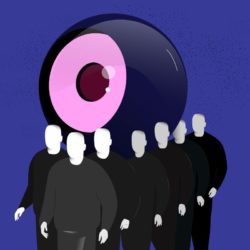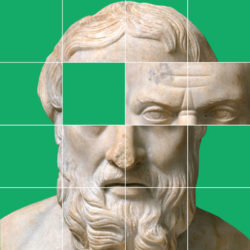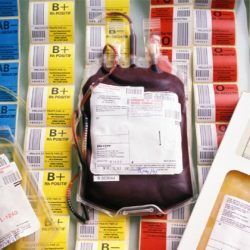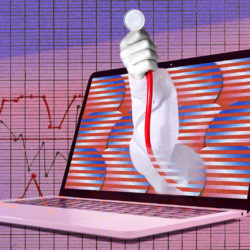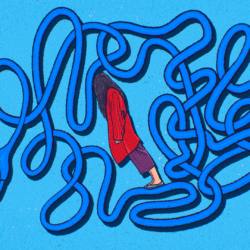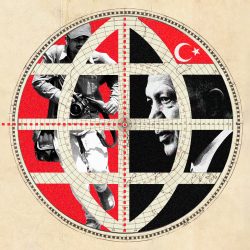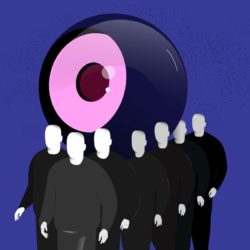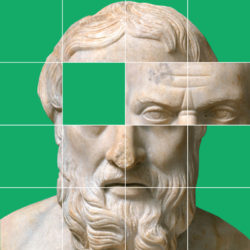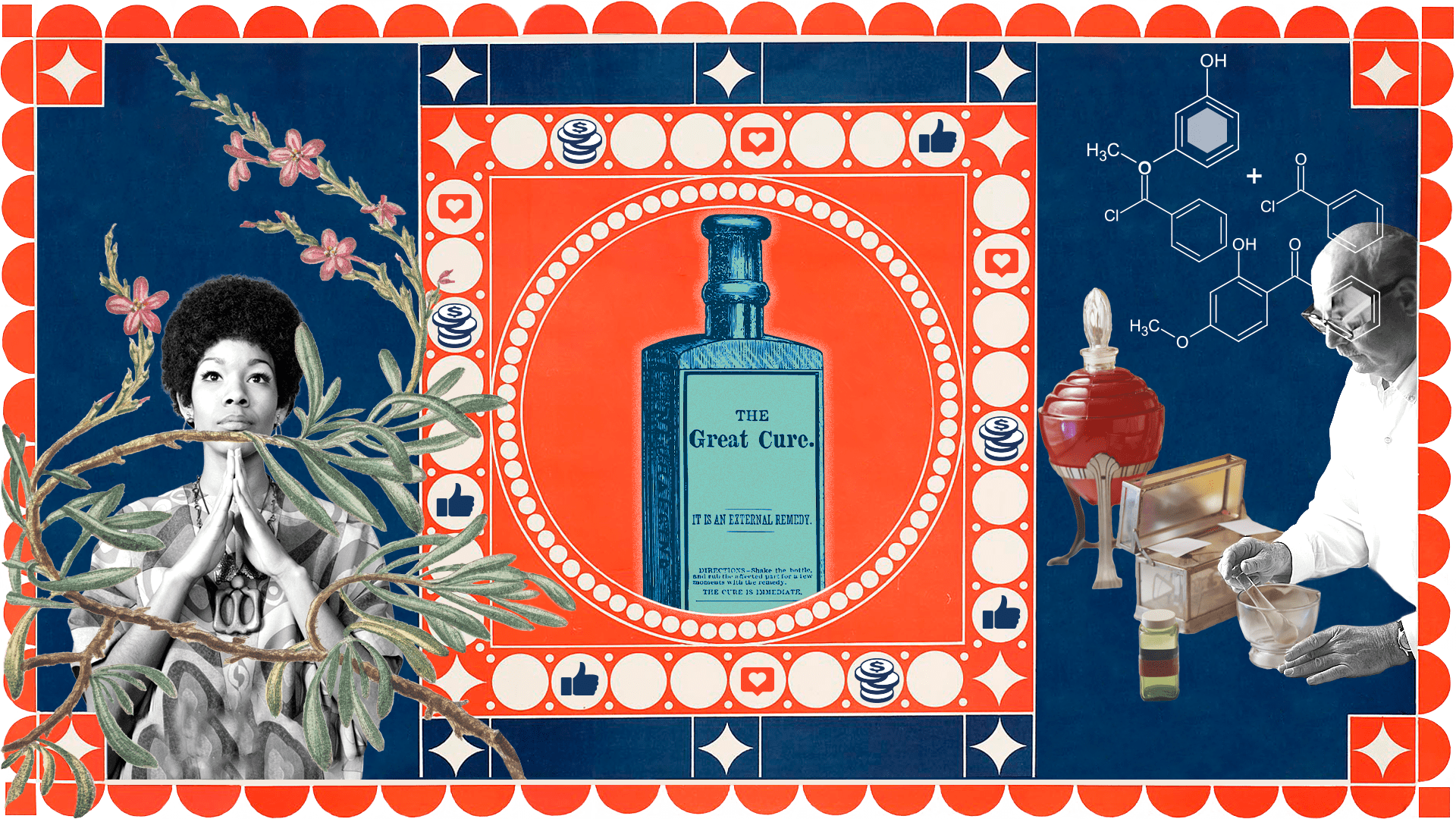
Teona Tsintsadze/Getty Images
The dangerous myths sold by the conspiritualists
- Illustrations by Teona Tsintsadze
Patches of pale skin on chiropractor Melissa Sell’s back and shoulders have been turned neon pink by the sun. “This is not a burn,” she tells her nearly 50,000 Instagram followers, “this is light nutrition.”
The “unhelpful invocation” of the term “sunburn,” she argues, makes “an unconscious mind feel vulnerable and fearful of the sun.” She welcomes this color, insinuating that you should too.
Decades of research have shown that sunburns are strong predictors of melanoma. Roughly 8,000 Americans are expected to die this year from the most serious type of skin cancer, melanoma, according to the American Cancer Society. Skin cancer is the most common form of cancer in the United States, and melanoma rates doubled between 1982 and 2011.
Still, Sell is not alone in the anti-sunscreen camp. Even Stanford University neuroscientist Andrew Huberman, host of the wildly successful podcast “Huberman Lab,” claims that some sunscreens have molecules that can be found in neurons 10 years after application. No evidence is offered. Elsewhere, he has said he’s “as scared of sunscreen as I am of melanoma.” Huberman’s podcasts are frequently ranked among the most popular in the U.S.; he has millions of followers on YouTube and Instagram and has been the subject of admiring magazine profiles.
Spreading misinformation and even conspiracy theories has become commonplace in wellness spaces across social media. In a politically charged atmosphere addicted to brokering in binaries, good science is too often sacrificed at the altar of partisan opinion.
Pushing back against medical advancements from as far back as the 19th century has become a rallying cry for a growing number of today’s conspiritualist contrarians. Fear mongering about vaccinations is not the only entry point to this strange world of conspiracy and misinformation, in which predominantly white, middle- or upper-middle-class wellness influencers propagate and sell ideas and products with little to no oversight. In this world, humans are godlike creatures immune to viruses and cancers, while those who fall victim to illness and therefore the twisted machinations of society are but collateral damage.
In May 2020, I launched the “Conspirituality” podcast with Matthew Remski and Julian Walker. Veteran yoga instructors deeply embedded in the wellness industry, we’ve long been skeptical about many health claims proffered by wellness influencers and the cult-like behaviors that appear in so-called spiritual communities. And we’ve always been attuned to the monetization of health misinformation.
Conspirituality is a portmanteau of “conspiracy” and “spirituality,” coined in 2011 by Charlotte Ward and David Voas in an academic paper. They observed a strange synthesis between “the female-dominated New Age (with its positive focus on self) and the male-dominated realm of conspiracy theory (with its negative focus on global politics).” The pandemic provided fertile ground for conspirituality, moving it from the fringe to the mainstream.
Specifically, we launched the podcast after the release of the 2020 pseudo-documentary “Plandemic.” Filmmaker Mikki Willis, who had moderate success in the Los Angeles wellness and yoga scene a decade or so ago, found a much larger audience with right-leaning conspiracy theorists — so much so that he was joined by Alex Jones at the red carpet premiere in June this year of the third installment of the “Plandemic” series. Many other former liberals in the wellness space have taken a hard right turn, including comedian and aspiring yogi Russell Brand. Brand now regularly hosts conspiracy theorists in part of what these days appears to be a gambit to deflect against numerous sexual abuse allegations against him made public earlier this month.
Not all conspiritualists are hard right, though their rhetoric predominantly leans that way. One of America’s most infamous anti-vaxxers, Robert F. Kennedy Jr., for instance, is attempting to combat President Joe Biden in the Democratic Party presidential primaries from the left. Predictably, Kennedy’s health policy roundtable, held on June 27, featured other leading health misinformation spreaders.

While the anti-vaccination movement began the moment Edward Jenner codified vaccine science, the modern upswell of anti-vax fervor dates back to disbarred physician Andrew Wakefield’s falsified research that purported to link vaccinations to autism in 1998. Hysteria around COVID-19 vaccines began months before a single one hit the market, in large part thanks to misinformation spread by “Plandemic.” And that trend shows no sign of slowing.
Health misinformation is likely as old as consciousness. The learning curve in understanding which plants heal and which kill took millennia without the benefit of controlled environments. While no science is perfect, to deny or disavow the progress we’ve made is absurd. The 19th century was an especially fruitful time, with vaccinations, antibiotics, germ theory and handwashing greatly advancing our biological knowledge.
Germ theory is a foundational tenet of modern science. For centuries, miasma theory was the favored explanation for the Black Plague, cholera and even chlamydia. These diseases were supposedly the result of “bad air,” which the ancient Greek physician Hippocrates claimed originated from rotting organic material and standing water.
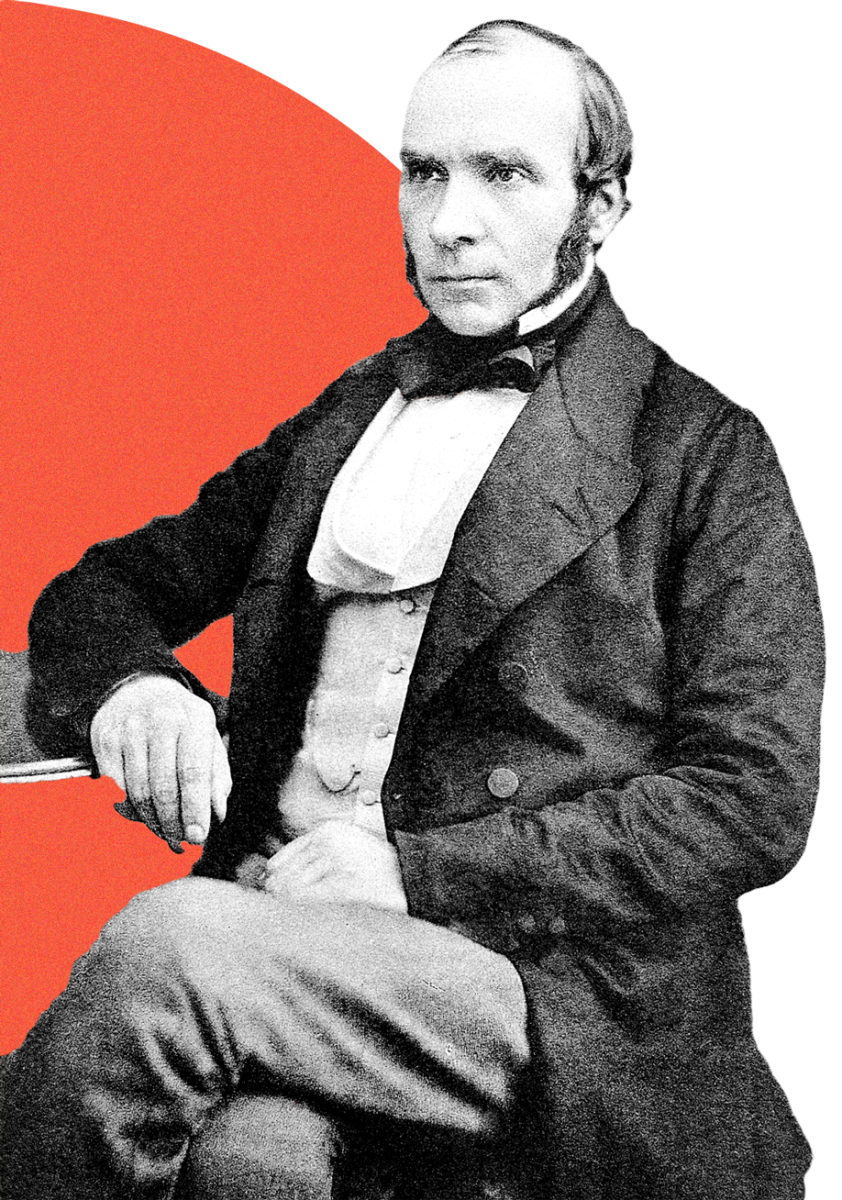
In 1857, English physician John Snow submitted a paper tracing a cholera outbreak to contaminated water from a pump in London’s Broad Street. Adoption of sanitary measures was slow and grudging. Civic authorities weren’t interested in the expense of rerouting pipelines.
A few years later, French chemist Louis Pasteur discovered a pathology of puerperal fever, though it wasn’t until Robert Koch photographed the anthrax bacterium in 1877 that disease was undeniably linked to bacteria. Medicine was changed.
Contemporary contrarian wellness influencers also trace their antecedents back to the 19th century. While Pasteur won fame — pasteurization remains an important practice for killing microbes — some of his colleagues resisted his findings. French scientist Antoine Béchamp devised the pleomorphic theory of disease: It’s not that bacteria or viruses cause diseases; it’s just that they’re attracted to people already susceptible to those diseases.
As Pasteur and Koch continued their research on microorganisms, Béchamp faded into obscurity. But his “terrain theory” lingered. It was the harbinger of the infamous “law of attraction,” the belief in the power of manifestation, of effectively imagining wealth, health and success into being. It’s the school of thought that, repackaged, made books like Rhonda Byrne’s “The Secret” (2006) a global bestseller.
Extended to physical wellbeing, it means that if your mindset is “correct,” disease has no pathway into your body. This ideology is behind the many products and courses sold by wellness influencers. In 2017, pseudoscience clearing house GreenMedInfo published an article in which the writer described Pasteur as the “original scammer” who enabled “the pharmaceutical industry to dominate and tyrannically rule modern Western medicine.” If you can sell the public on a pathology of disease, the writer argued, you can sell a cure.
He championed a return to nature as the real way to protect against disease: “Detoxing and seeking fresh whole foods and adding the proper supplements offer more disease protection from germs than all the vaccines in the world.”
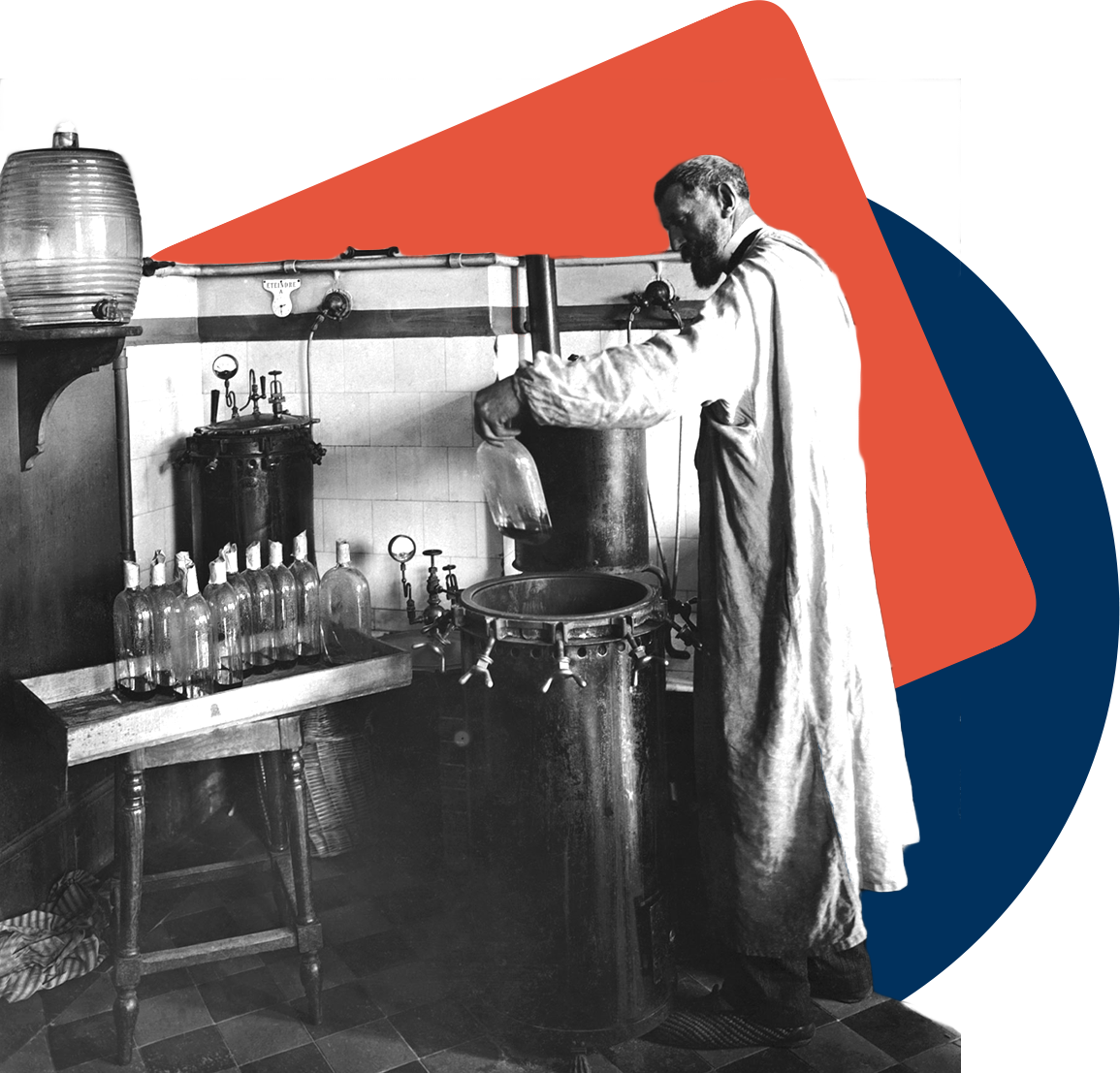
Terrain theory has no greater proponent than Zach Bush, a physician who rightfully argues that the environment plays a role in health outcomes. But then he goes on to say that since there are billions of viruses, it must really be unhealthy tissues making the victim susceptible to disease — Antoine Béchamp’s exact argument. Bush claims that viruses are nature’s way of upgrading our genes, and any ailment must be due to a bodily imbalance.
This form of magical thinking is spread across his many web pages. Instead of conducting actual research on COVID-19 as an internist, Bush offered statements like this to his million-plus followers: “May this respiratory virus that now shares space and time with us teach us of the grave mistakes we have made in disconnecting from our nature and warring against the foundation of the microbiome. If we choose to learn from, rather than fear, this virus, it can reveal the source of our chronic disease epidemics that are the real threat to our species.”
In April, Bush told an Irish podcast that if he were to take a single course of antibiotics, his chances of “major depression over the next 12 months goes up by 24 percent.” Two courses, and he claimed that he would be 45% more likely to contract anxiety disorders and 52% more likely to suffer depression. The podcast’s hosts made a public apology, though Bush continues to be able to spread his misinformation. Inevitably, Bush sells a range of supplements “key to our overall health and wellbeing.”
Watch what they say, then watch what they sell. If an influencer tells you Western medicine has failed you, be sure a product pitch is coming. Supplements are the main vehicle to monetization for wellness influencers since they don’t have to be clinically tested and little regulated, existing in a medical gray zone. Consumers mostly ignore the fine print on the back label because the promises on the front are so much more appealing.
Like Bush, influencers such as Jessica Peatross sell supplements and protocols to her well over 300,000 Instagram followers while consistently invoking Béchamp. “Terrain theory matters,” Peatross wrote in a March 2023 post. “When your body’s symphony isn’t in tune, or you are out of homeostasis, you are much more vulnerable to pathogenic invasion, cancer or autoimmunity.”
Last year, Peatross surrendered her medical license in California due to vaccine requirements. Now she sells subscription health plans. When signing up for her email list, you get a link to download her “Vaccine Protection & Detox Protocol.”
All proponents of terrain theory put the onus of disease on the individual. They demand we each fend off the toxic effects of Big Pharma, Big Ag and all the other Bigs in existence through supplementation, meditation, breathwork, psychedelic rituals in Bali, or simply by thinking positively, thinking the “right way,” a learned skill for which they always have a course.
Among the more notorious pushers of terrain theory doctrine was German physician Ryke Geerd Hamer, the inventor of Germanic New Medicine. In 1995, already discredited and stopped from practicing medicine in Germany, he diagnosed a 6-year-old girl as having “conflicts.” As a result, her parents refused to treat the 9-pound cancerous tumor in her abdomen. An Austrian court stripped them of custody, so that she could receive the chemotherapy that saved her life.
Hamer, who died in 2017, believed medicine was controlled by Jewish doctors who used treatments like chemotherapy on non-Jewish patients. Perhaps unsurprisingly, many pseudoscience claims and conspiracies are rooted in antisemitism. Hamer also promoted the idea of microchips in swine flu vaccines and denied the existence of AIDS.
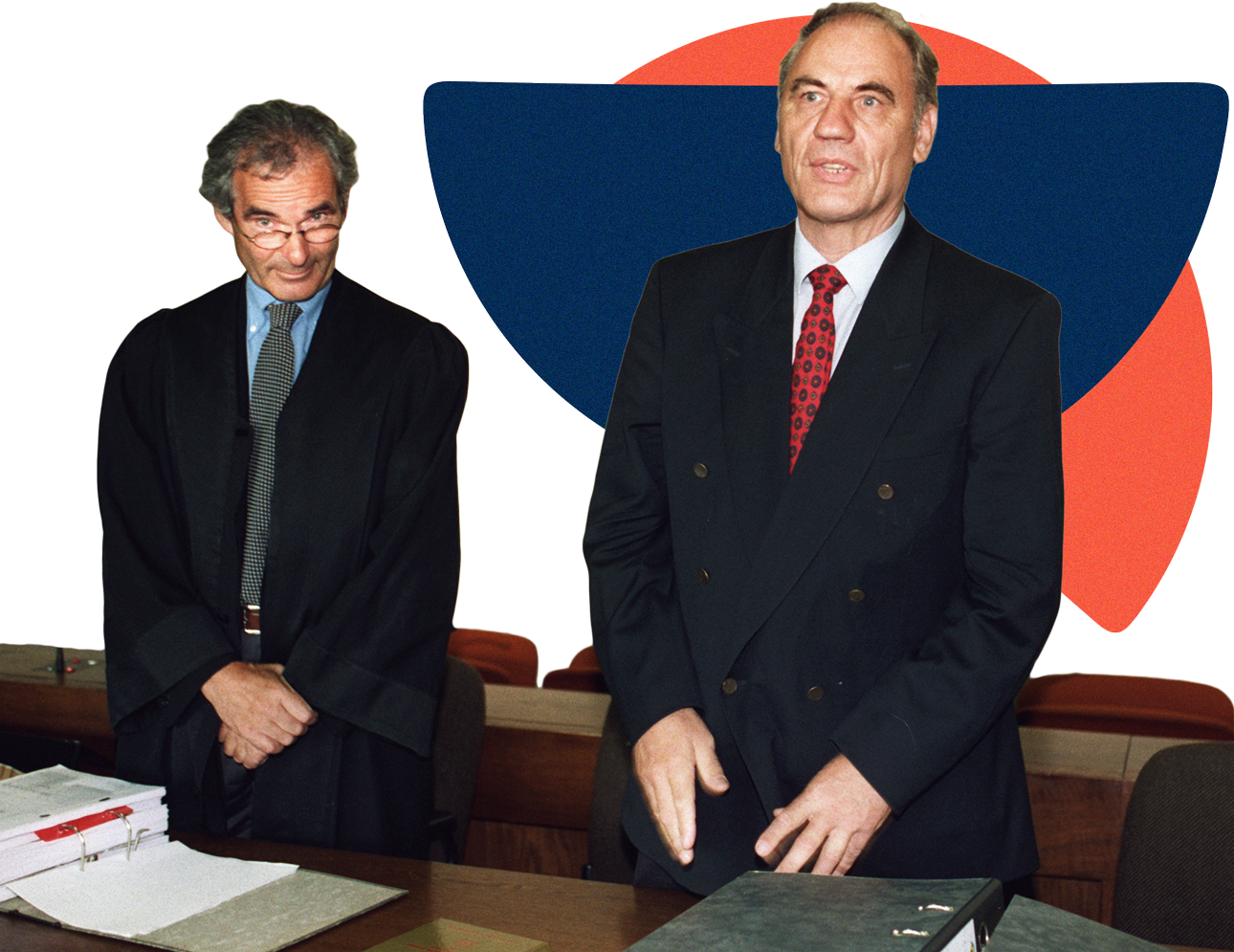
Germanic New Medicine is based on the “five biological laws,” which claim that all severe disease is due to a shock event. If the victim doesn’t immediately solve their conflict, the disease progresses in the brain. Microbes actually enter the body to heal it, provided the victim addresses the psychological conflict that led to the proliferation of the disease state. The victim heals after confronting the conflict, which Hamer thought nature had intentionally placed there to teach some sort of lesson. Death only occurs when you don’t face the trauma of the shock event. So that’s on you.
Disease exists to teach a lesson. A sunburn is light nutrition. It’s no wonder that Melissa Sell is one of the most vocal revivalists of Hamer’s theories, which she has renamed “Germanic Healing Knowledge.” She uses social media to share thoughts like: “You are not ‘sick’. Your body is adapting to help you through a difficult situation. When you resolve that situation your body will go through a period of restoration and then return to homeostasis.”
Sadly, this is par for the course. With my podcast colleagues, Matthew and Julian, our review of conspiritualists found that the notion of an “ideal” body or way of being is widespread. As we document in our book, modern yoga was in part influenced by the famed 19th- and early 20th-century German strongman Eugen Sandow, whose adopted first name is a truncation of “eugenics.”
Yoga originated in India, yet Sandow’s techniques found an audience among Indians in the late 19th century. Feeling emasculated and humiliated by British colonialists, many Indians appreciated Sandow’s overt masculinity and mimicked his strength techniques in a set of yoga postures that are now widely used. Indians craved bodily strength as a metaphor for overcoming colonial rule. Sandow came at it from the other side. He used his physique to further an explicitly racist world view. There was a reason why the strong white race dominated the world, he seemed to be saying — just watch me flex my biceps.
Wellness influencers similarly obsess over a strong and purified body. They assign similar causes to all ailments, which usually include poor diet, a lack of exercise, modern medicine and an inability to escape toxic stress. Sometimes, however, the influencer assigns physical attributes to the perfected body, which is why anti-trans bigotry and fat-shaming run rampant in wellness spaces. The ideal body, which can only be accomplished by resisting the evil mechanisms of allopathic (Western) medicine, is the true goal of nature’s design. Strangely, a number of these same influencers take no issue with cosmetic surgeries, botox or steroids, yet scream at followers for using deodorant or applying sunscreen.
So what is the “right” sort of existence that lets the victim recover and achieve homeostasis, a state of internal balance consistent with Hamer’s five biological laws? According to Sell, as she explained on X, formerly known as Twitter, “The way to feel better is to think better thoughts.” Naturally, she has a number of online courses available to help you think better thoughts, ranging in price from $111 to $2,700.
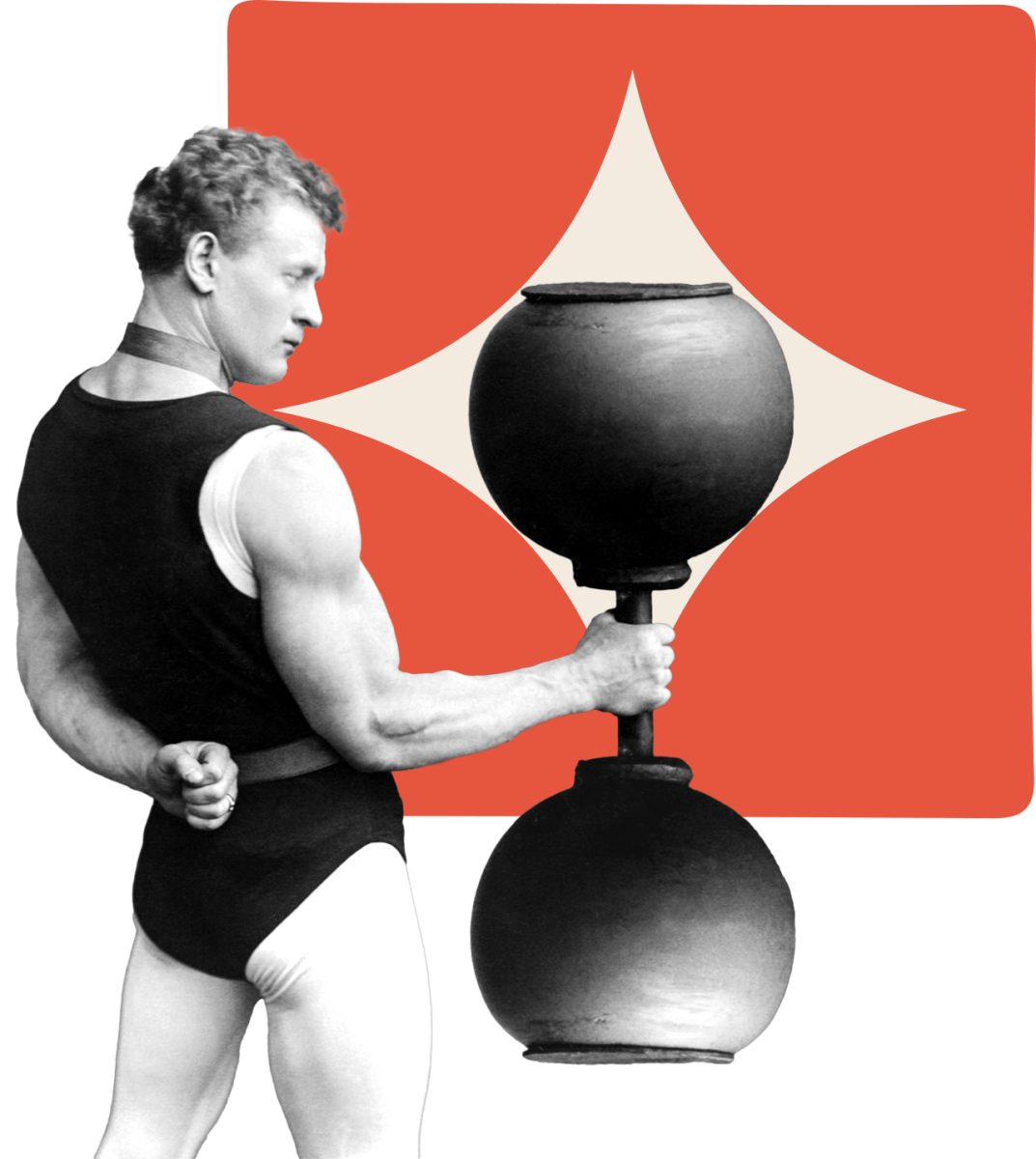
In 1810, German physician Samuel Hahnemann came up with the term “allopathy” as a strawman to his concept of homeopathy. Whereas homeopathy means “like cures like,” allopathy initially meant “opposite cures like.” In the allopathic system, for instance, you take an antidiarrheal to treat diarrhea; in homeopathy, you take a laxative. Well, the “essence” of a laxative.
Allopathy has come to mean anything involving Western medicine, while homeopathy is considered a natural system for healing (even though ground-up pieces of the Berlin Wall are used in one homeopathic remedy, and I don’t recall concrete ever forming without human intervention).
Hahnemann left his role as a physician in 1784 due to barbaric practices like bloodletting. He supported his family by translating medical textbooks. Inspired by Scottish physician William Cullen’s book on malaria, he slathered cinchona — a quinine-containing bark — all over his body to induce malaria-like symptoms. Hahnemann likely developed an inflammatory reaction, though he credited them as “malaria-like symptoms.” He then believed himself to be inoculated against malaria. This experience became the basis of homeopathy.
Instead of ingesting (or slathering on) small quantities of an offending agent, Hahnemann removed the active ingredient altogether from his distillations. He believed that less substance equals higher potency, and kept following that trail: Most homeopathic products contain no active ingredient.
Take Oscillococcinum, one of France’s top-selling medicines, which rakes in $20 million in America every year. The process of potentization — homeopathy’s dilution protocol — begins with the heart and liver of the Muscovy duck. Technicians mix 1 part duck heart and liver with 100 parts sugar in water. Then the process is repeated 200 times, which means any trace of the duck is long gone. The late family physician Harriet Hall pointed out that you’d need a container 30 times the size of the earth just to find one duck molecule. Yet it’s marketed to reduce flu symptoms.
When a spokesperson for Boiron, the manufacturer of Oscillococcinum, was asked if their product was safe, she replied: “Of course it is safe. There’s nothing in it.”
Despite an absence of active ingredients, homeopathic products are often mistaken for herbal remedies, according to Jonathan Jarry, a science communicator with the Office for Science and Society at McGill University. In his article, Jarry cites a Health Canada survey that shows only 5% of Canadians understand what homeopathy entails. Pharmacies and grocery stores confuse customers by shelving these products next to herbal remedies and other medicines.
When I asked Jarry about the danger of consumer confusion, he said, “Homeopathic products are based on sympathetic magic principles and are not supported by our understanding of biology, chemistry and physics. So when they’re sold alongside actual pharmaceutical drugs, it creates a false equivalence in the mind of the shopper. It bumps homeopathy up to the level of medicine and turns its products into pharmaceutical chameleons.”
Homeopathy suppliers want it both ways: They claim their products are superior to pharmaceuticals while pushing to have them shelved next to actual drugs to obscure their difference. The name of their 100-year-old trade group? The American Association of Homeopathic Pharmacists.
Jarry has helped lead the charge for proper labeling of homeopathic products in Canada. Over the border, in the U.S., the Federal Trade Commission began regulating homeopathic products in 2016, though these efforts seem to have had little impact. The global homeopathic market is expected to reach nearly $20 billion by 2030.
Jarry thinks regulatory agencies must work harder to make clear that homeopathy is not based on science. But everyone passes the buck. “The pharmacists who own drug stores in which homeopathy is sold,” Jarry told me, “say that it’s up to the chain they work for to tell them to stop selling these products.” Meanwhile, “the chains say the products are approved by Health Canada, whose representatives say it’s up to pharmacists to use clinical judgment when recommending them or not.”
While the risk of injury is low given that most homeopathic products contain no active ingredient, there’s another danger lurking beneath the surface — people choosing to use these products instead of seeking out interventions that can actually help them.
Avoidance of “allopathic” medicine is common in wellness spaces, the belief being that natural cures are better than anything concocted in a laboratory. The stakes are particularly high when it comes to mental health.

We’ve included a chapter called “Conspiritualists Are Not Wrong” in our book to acknowledge the fact that many people turn to natural remedies and wellness practices with good intentions. The American for-profit healthcare system can be a nightmare. We likely all have anecdotes of when the system failed us. Just as we all have likely benefited from Western medicine. It often depends on where your attention is most drawn.
Like many wellness professionals, I lost a lot of income when the pandemic struck. All of the group fitness and yoga classes that I ran were gone overnight. My wife, who worked in hospitality at the time, lost her job. We were fortunate to have enough savings to get by, along with whatever income I pulled together as a freelance writer and by livestreaming donation yoga classes on YouTube. Our story isn’t unique, and it makes sense that wellness professionals turned to whatever revenue they could find.
I wasn’t surprised to see so many supplements and online courses being marketed in the first months of the pandemic. But the sheer number of mental health interventions sold by wellness influencers was astounding — and concerning. Everyone seemed to have a hot take on mental health, and many leaned on the appeal to nature fallacy: You can heal depression with a supplement or a meditation practice or by cultivating the right mindset.
“Holistic psychiatrist” Kelly Brogan, who is clinically trained but took a right turn even before the pandemic began, offers tapering protocols from antidepressants — even though none exist — to paying clients. True, pharmaceutical companies that know how to get patients onto their medications have never bothered to figure out how to get them off. But beware the influencer who writes, as Brogan does, “Tapering off psychiatric medication is a soul calling. It is a choice that you feel magnetized toward and will stop at nothing to pursue.”
Jonathan N. Stea is a clinical psychologist and adjunct assistant professor at the University of Calgary. A prolific science communicator, he doesn’t mince words when I ask him about wellness influencers who claim that natural remedies are better than antidepressants.
“I’m tired of wellness influencers unethically opining on topics they’re unqualified to understand,” he said. “Notwithstanding the appeal to nature fallacy with respect to the idea that there are ‘better natural remedies’ than evidence-based psychiatric medications, it’s irresponsible to make such claims in the absence of scientific evidence.”
The paradox of the wellness industry is that you supposedly thrive when you connect with nature, yet you also need endless products and services. Self-professed metaphysics teacher Luke Storey, for example, sells over 200 products that offer the “most cutting-edge natural healing” that jive with his love for “consciousness expanding technologies.” How much healing does one really need? How contracted is consciousness that it requires so much expansion?
It’s one thing to enjoy spiritual tchotchkes, but telling people these accouterments are necessary for salvation is disingenuous.
The problem is that people don’t necessarily feel better with these protocols or products. The way the wellness grift is framed — the notion that your thoughts dictate your reality — results in the adherent feeling worse if the therapeutic doesn’t work. They believe it’s a moral failing because charismatic influencers place the burden on them: “You didn’t do x or y hard enough.” So back on the treadmill they go.
Tragically, Stea said some people suspend antidepressant usage to chase magical-sounding cures. “Abrupt cessation of these medications can result in awful withdrawal symptoms,” he told me. “The other risk is that forgoing medications for unsupported or pseudoscientific treatments carry their own potential for harm, either directly due to the treatment, or indirectly by possibly worsening an untreated mental disorder.”
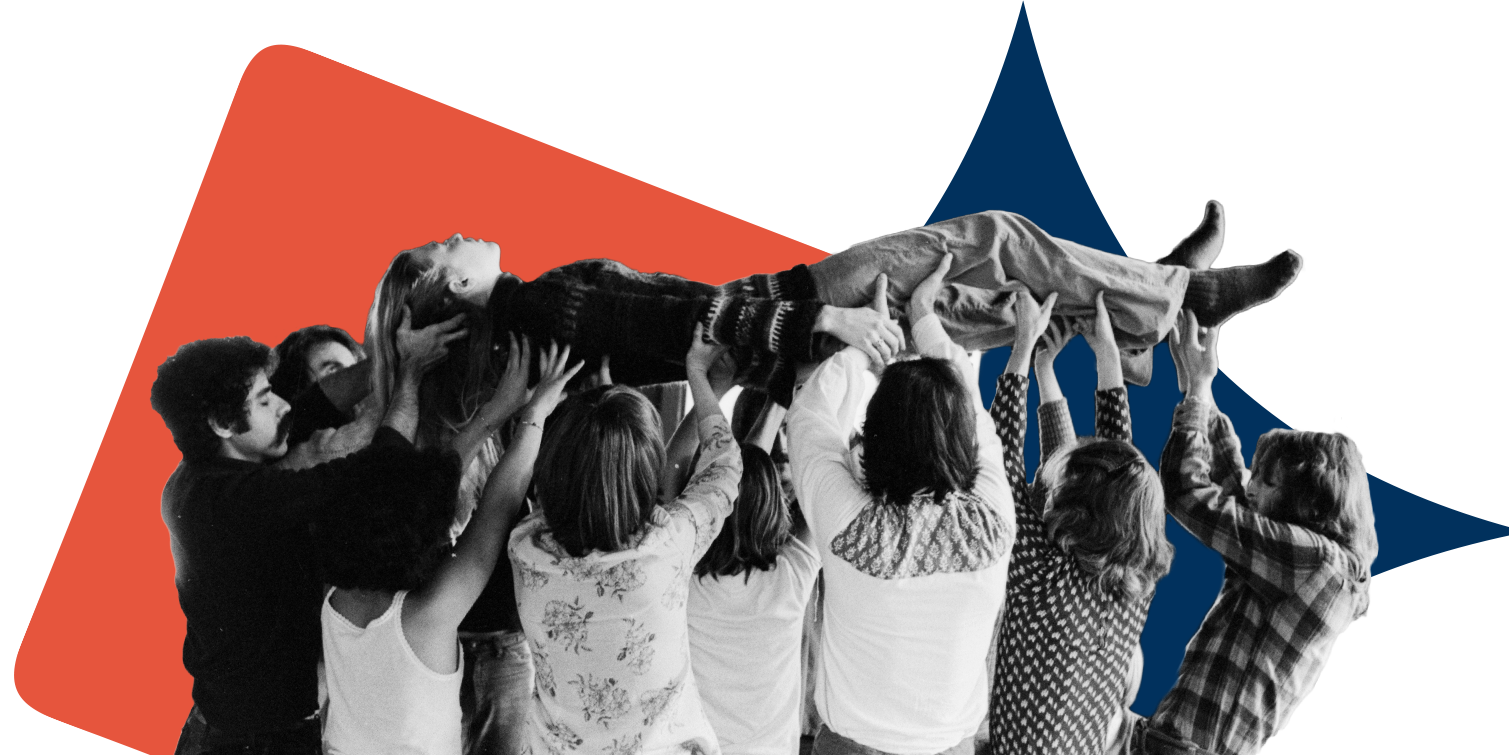
Roger Ressmeyer/Corbis/VCG via Getty Images.
People in pain are vulnerable. Unfortunately, there’s no silver bullet for depression, anxiety or suicidal ideation. At least accountability exists in regulated spaces. Pseudoscientific sermons on TikTok have no such oversight.
Ideally, science tests claims with the best available means at the time. If better tools emerge, findings are updated. Conspiritualists are regressing in this regard. Their romanticization of 19th-century pseudoscience is a ruse that helps them sell products and services.
In many ways, we’re victims of our own success. The advancements of the 19th century in public health, hygiene and drugs are part of the reason most of us are here today. Like the proverbial fish that doesn’t know it’s swimming in water, we’re all afloat in the hard-won progress of centuries of trial and error.
We’re also not the same animals that gave birth to our line 100,000 years ago or even 1,000 years ago. For better and worse, we’ve drastically changed our relationship to our environment, just as we have drastically changed the environment. Glamorizing who we were neglects what we’ve become and how we got here.
Michelle Wong, a science educator and cosmetic chemist based in Australia, told me that when the likes of Melissa Sell make their anti-sunscreen pitches, they rely on the appeal to nature fallacy. “There’s the idea that humans evolved with sun exposure,” she said, “so our skin should be able to handle it. But skin cancers usually develop after reproductive age (which is all that evolution helps us with). On top of that, migration and leisure, like beach holidays, means we get very different sun exposure compared to how we evolved.” As the 16th-century Swiss physician Paracelsus once observed, what heals in small doses kills in large.
The sun, in other words, isn’t to be feared, but we would do well to respect its power. And to not overestimate our own.
The story you just read is a small piece of a complex and an ever-changing storyline that Coda covers relentlessly and with singular focus. But we can’t do it without your help. Show your support for journalism that stays on the story by becoming a member today. Coda Story is a 501(c)3 U.S. non-profit. Your contribution to Coda Story is tax deductible.
